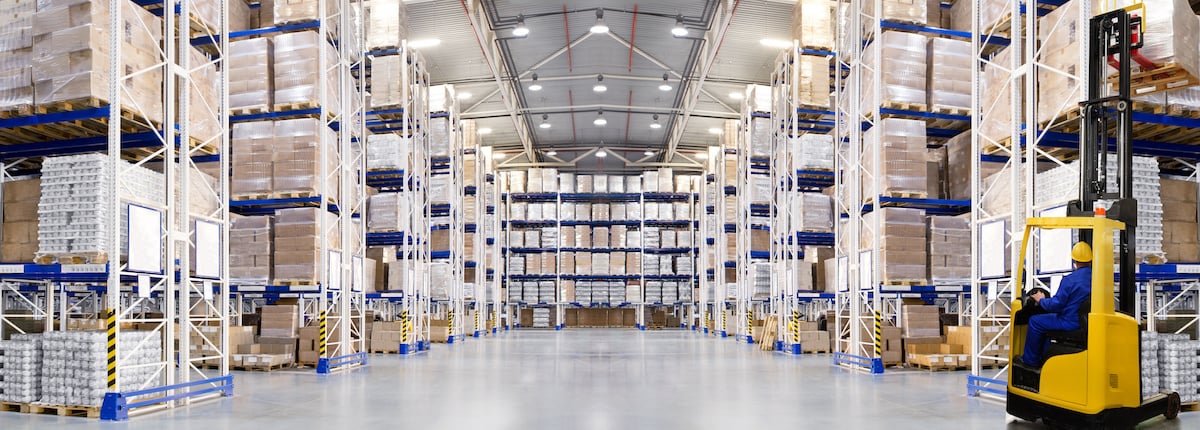With the nearly 46% growth ecommerce drove in 2020, many third-party logistics (3PL) warehouses have found themselves struggling with warehouse space and capacity to take on new customers.
Based on the Third-Party Logistics Warehouse Benchmark Report, nearly 41% of 3PLs identified opening new warehouses in geographies as a top opportunity for this year and 50% report operating their current facilities at 90% capacity. Compound that with 77% of 3PL warehouses saying they plan to acquire new customers this year. How will they have the space to grow?
Warehouse Space Vacancy Rates
Last year, warehouse space and availability dropped to near record lows. CBRE, the world’s largest commercial real estate firm, summarized trends in their recent Industrial Big Box Report for North America where they highlighted near record-low vacancy rates of 4.6% for warehouse space. While that may sound palatable, when you look at key markets like Toronto (0.3%), 3PL Warehouse in Montreal (1.1%), Northern/Central New Jersey (1.3%), 3PL Warehouse Seattle (2.0%, and Los Angeles (~2.3%) all having less than 3% direct vacancy rate, the picture looks a bit grimmer.
Not only that, but of all warehouse spaces under construction in North America, nearly 43.7% of them are already pre-leased. Some of the most competitive markets are expected to see dramatic growth in rents, with markets like Los Angeles expecting to increase rents by nearly 41% by the year 2025.
Geographies in Demand by 3PL Warehouses
The trends driving warehouse geography selection revolve around concentration of consumers (or where deliveries occur), shipping costs, and the ability to meet next day or two-day shipping requirements.
With shipping costs increasing significantly in the past year, 3PL warehouses have to work with their customers to identify the best locations for geographic expansion based where they can get the most cost-effective shipping costs that allows for two-day or next day shipping for the end consumer. That’s where the good news comes in…people have migrated to different parts of the country, allowing for more location options for 3PLs.
People are migrating from major metropolitan centers like Los Angeles and New York City to states like Idaho, Arizona, South Carolina, and Tennessee. Places like Phoenix, Dallas, and Denver have become better options for better servicing consumer needs.
What to Do if You Can’t Find Available Warehouse Real Estate
With all of the competition for space, many 3PLs may not have the ability to expand into their desired geographies and may wonder what to do if they can’t find space.
If a 3PL warehouse can’t find additional space, some recommendations to still allow for growth include:
- Consider Existing Warehouse Layout – First start by ensuring you optimize your current space for maximum utilization. Have you optimized your facility for FAST principles? Do you have the ability to build up vertically and add another layer of storage above current spaces?
- Evaluate Slow- Moving Inventory – Consider the inventory turnover in the space you currently have. Do you have significant space consumed by slow moving inventory? 3PL warehouses can increase revenue and/or persuade customers to reduce stock of slow- moving inventory by pricing longer term storage higher to ensure that inventory doesn’t take up valuable space that could drive more business.
- Identify Surge / Overflow Space in Current Locations – Once you identify slow-moving inventory, consider looking for surge or overflow space at a nearby warehousing and distribution. What businesses in the area have recently seen a downturn? What other warehouses do you know of in the area? Start by consulting with other nearby warehouses to see if you can negotiate favorable overflow storage for slow moving items. This can allow you to open up space for new customers and growth.
- Partner with 3PLs in other Geographies – 3PL warehouses should consider partnering with other 3PLs in target geographies where they are unable to acquire additional space. It can allow them to quickly move into a market without the same level of overhead. 3PLs should consider partnering with other 3PLs that share their same warehouse management system (WMS) for ease of transferring data.
Warehouse Real Estate Trends
For more information on warehouse real estate trends or to hear CBRE’s outlook of the market for 2021, watch our webinar on-demand here.
To get content like this delivered to your inbox weekly, subscribe to the Extensiv blog.






